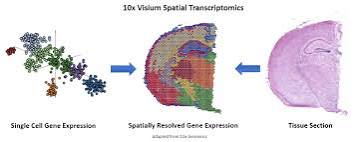The field of spatial transcriptomics is currently leading a significant shift in genetic research, offering a groundbreaking perspective on the intricate operations of gene expression within tissue structures. This approach does not just highlight the specific locations of gene activities but also sheds light on the intricate interplay within biological entities.
The introduction of precise methods such as DBiT-seq and its derivatives, facilitating spatial mapping of tissues with accuracy up to 10 μm, has greatly advanced our comprehension of cellular environments in various scientific areas, including studies focused on the respiratory system. With the advent of these sophisticated technologies in mind, we will delve into the ways spatial transcriptomics is revolutionizing genetic research on a molecular level and its profound impact on our understanding of life.
Understanding the Basics of Spatial Transcriptomics
Spatial transcriptomics represents a pioneering method that associates gene expression data with their specific locations within tissues, enabling the visualization of gene activity patterns across numerous genes at once.
This technology broadens our understanding of cell functions and the pathology of diseases, moving us past the constraints of conventional transcriptomics approaches. By providing a holistic view of gene function within their natural tissue environments, spatial transcriptomics offers a deeper insight into biological processes and the onset of diseases, guiding the development of more effective therapeutic interventions.
Technological Breakthroughs in Imaging
Recent breakthroughs in imaging technologies have transformed our capacity to examine tissue structures with remarkable detail and clarity, significantly improving the analysis of both tissue architecture and gene expression. These technological advancements unveil the complex dynamics within biological tissues, essential for comprehending how cellular contexts affect gene activity, and why they’re crucial for unraveling the mechanisms of health and disease.
A key milestone in this journey has been the visium spatial transcriptomics solution, which connects gene expression data to precise tissue locations, enhancing our grasp of cell functions and tissue structure. This integration of state-of-the-art imaging and transcriptomic analysis allows for detailed mapping and quantification of spatial gene expression patterns, playing a pivotal role in revealing new insights into tissue biology, disease processes, and cellular diversity.
Visium spatial transcriptomics not only highlights the advancements in imaging techniques but also underscores a significant leap toward future genetic and cellular biology research, aiming to disclose the complexities hidden within the spatial arrangement of genes.
Synergy with Computational Biology
The significance of computational biology within the scope of spatial transcriptomics has escalated to an essential status, providing a suite of sophisticated tools and algorithms for dissecting complex datasets.
The synergy of artificial intelligence and machine learning with biological datasets facilitates a more nuanced analysis and decoding of genetic data, empowering researchers to detect patterns and derive once-inaccessible insights. This fusion is propelling the field of genetic studies into uncharted territories, augmenting our skills to demystify the intricate details of existence at a molecular level.
Advancements in Disease Research and Therapeutic Approaches
Spatial transcriptomics is at the forefront of a groundbreaking shift in the investigation of diseases and the formulation of treatment strategies, by integrating a spatial perspective into the analysis of gene expression data.
This innovative approach has carved out novel avenues for a deeper comprehension of the foundational aspects of various health conditions, including cancer and neurological disorders, providing critical insights for the development of precise treatments.
The capability to chart the progression of diseases and monitor the efficacy of treatments with exceptional accuracy marks pivotal progress in the realm of personalized healthcare, enabling the customization of treatment plans according to the unique genetic profiles of individuals.
Addressing Challenges and Future Prospects
While spatial transcriptomics offers transformative potential, it is not without its challenges, including technical obstacles and the complexity of data interpretation. Striking a balance between the efficiency of mRNA capture and minimizing data distortion remains a technical challenge, as well as scaling up these technologies for broader applications. Overcoming these challenges necessitates ongoing innovation and interdisciplinary collaboration, highlighting the importance of a comprehensive strategy to surpass the current limitations of spatial transcriptomics.
Emerging Technologies and Future Directions
Looking forward, the domain of spatial transcriptomics is poised for significant advancements, with forthcoming technologies anticipated to enhance aspects of resolution, efficiency, and user accessibility.
These innovations are set to enrich our comprehension of genetic and cellular biology, providing fresh perspectives on the molecular structure of living organisms. The amalgamation of newly developed technologies with time-tested techniques is likely to foster novel investigative pathways into the intricacies of biological systems, signifying a vibrant period of exploration and insight in the field of genetic studies.
Conclusion
Spatial transcriptomics is redefining the landscape of genetic research by providing an enriched and detailed perspective on gene expression within its tissue context. This technology is pivotal in unveiling the complexities of biological processes, from disease development to the nuanced interplay of cells. As we venture further into this fascinating field, the potential for novel discoveries and applications in genetics is immense. Together, we embark on this groundbreaking path of genetic inquiry, eager to explore the vast secrets encoded within our genes.

Isreal olabanji a dental assistant and public health professionals and has years of experience in assisting the dentist with all sorts of dental issues.
We regularly post timely and trustworthy medical information and news on Fitness, Dental care, Recipes, Child health, obstetrics, and more.
The content is intended to augment, not replace, information provided by your clinician. It is not intended nor implied to be a substitute for professional medical advice. Reading this information does not create or replace a doctor-patient relationship or consultation. If required, please contact your doctor or other health care provider to assist you to interpret any of this information, or in applying the information to your individual needs.


